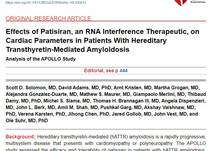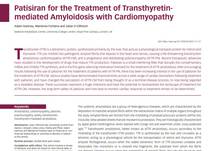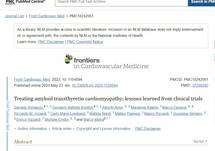Once thought to be a rare disease, transthyretin amyloidosis that results in cardiomyopathy (ATTR-CM) remains a challenge to diagnose and treat. In this discussion, Drs. Mazen Hanna and Marianna Fontana provide expert advice on imaging techniques to diagnose ATTR-CM, including recognizing diagnostic “red flags.” They also review recent clinical trial data of current and potential therapeutics for ATTR-CM, so listen in to find out how you can put the evidence into practice.
Disclosure of Conflicts of Interest
In accordance with the ACCME Standards for Integrity and Independence, Global Learning Collaborative (GLC) requires that individuals in a position to control the content of an educational activity disclose all relevant financial relationships with any ineligible company. GLC mitigates all conflicts of interest to ensure independence, objectivity, balance, and scientific rigor in all its educational programs.
Faculty:
Marianna Fontana, MD
Director of the UCL CMR Unit, Royal Free Hospital
Professor of Cardiology and Honorary Consultant Cardiologist
National Amyloidosis Centre, Division of Medicine
University College London
London, UKConsulting Fees: Akcea, Alexion, Alnylam, AstraZeneca, Attralus, Intellia, Ionis, Janssen, Novo Nordisk, Pfizer, Prothena
Research: Alnylam, Eidos, PfizerMazen Hanna, MD
Staff Cardiologist
Cleveland Clinic
Cleveland, OHConsulting Fees: Alexion, Alnylam, Eidos, Pfizer
Reviewers/Content Planners/Authors:
- Cindy Davidson has nothing to disclose.
- Howard Green has nothing to disclose.
- Brian P. McDonough, MD, FAAFP, has nothing to disclose.
- Tim Person has nothing to disclose.
- Colleen Resnick has nothing to disclose.
- Mara Siegel has nothing to disclose.
- Mario Trucillo has nothing to disclose.
Learning Objectives
After participating in this educational activity, participants should be better able to:
- Describe the prevalence and types of amyloid transthyretin amyloidosis with cardiomyopathy (ATTR-CM)
- Discuss the clinical manifestations and diagnosis of ATTR-CM
- Explain the treatment options for patients with ATTR-CM
Target Audience
This activity is designed to meet the educational needs of primary care professionals and cardiologists.
Accreditation and Credit Designation Statements
 In support of improving patient care, Global Learning Collaborative (GLC) is jointly accredited by the Accreditation Council for Continuing Medical Education (ACCME), the Accreditation Council for Pharmacy Education (ACPE), and the American Nurses Credentialing Center (ANCC) to provide continuing education for the healthcare team.
In support of improving patient care, Global Learning Collaborative (GLC) is jointly accredited by the Accreditation Council for Continuing Medical Education (ACCME), the Accreditation Council for Pharmacy Education (ACPE), and the American Nurses Credentialing Center (ANCC) to provide continuing education for the healthcare team. The American Medical Association has an agreement of mutual recognition of continuing medical education (CME) credits with the European Union of Medical Specialists (UEMS), the accreditation body for European countries. Physicians interested in converting AMA PRA Category 1 CreditsTM to UEMS-European Accreditation Council for Continuing Medical Education CME credits (ECMECs) should contact the UEMS at mutualrecognition@uems.eu.
Global Learning Collaborative (GLC) designates this enduring activity for a maximum of .25 AMA PRA Category 1 Credits™. Physicians should claim only the credit commensurate with the extent of their participation in the activity.
Global Learning Collaborative (GLC) designates this activity for .25 nursing contact hours. Nurses should claim only the credit commensurate with the extent of their participation in the activity.
Provider(s)/Educational Partner(s)

Our ultimate goal is to improve the care being delivered to patients, and our high-quality, evidence-based CME initiatives reflect our dedication to the creation and execution of excellence and are the product of shared research, knowledge, and clinical practice skills across the healthcare continuum.
Commercial Support
This activity is supported by an independent educational grant from Alnylam Pharmaceuticals, Inc.
Disclaimer
The views and opinions expressed in this educational activity are those of the faculty and do not necessarily represent the views of GLC and Medtelligence. This presentation is not intended to define an exclusive course of patient management; the participant should use his/her clinical judgment, knowledge, experience, and diagnostic skills in applying or adopting for professional use any of the information provided herein. Any procedures, medications, or other courses of diagnosis or treatment discussed or suggested in this activity should not be used by clinicians without evaluation of their patients’ conditions and contraindications or dangers in use, review of any applicable manufacturer’s product information, and comparison with recommendations of other authorities. Links to other sites may be provided as additional sources of information. Once you elect to access a site outside of Medtelligence you are subject to the terms and conditions of use, including copyright and licensing restriction, of that site.
Reproduction Prohibited
Reproduction of this material is not permitted without written permission from the copyright owner.System Requirements
- Supported Browsers (2 most recent versions):
- Google Chrome for Windows, Mac OS, iOS, and Android
- Apple Safari for Mac OS and iOS
- Mozilla Firefox for Windows, Mac OS, iOS, and Android
- Microsoft Edge for Windows
- Recommended Internet Speed: 5Mbps+
Publication Dates
Release Date:
Expiration Date:

















Facebook Comments